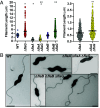FlaG competes with FliS-flagellin complexes for access to FlhA in the flagellar T3SS to control Campylobacter jejuni filament length
- PMID: 39441631
- PMCID: PMC11536152
- DOI: 10.1073/pnas.2414393121
FlaG competes with FliS-flagellin complexes for access to FlhA in the flagellar T3SS to control Campylobacter jejuni filament length
Abstract
Bacteria power rotation of an extracellular flagellar filament for swimming motility. Thousands of flagellin subunits compose the flagellar filament, which extends several microns from the bacterial surface. It is unclear whether bacteria actively control filament length. Many polarly flagellated bacteria produce shorter flagellar filaments than peritrichous bacteria, and FlaG has been reported to limit flagellar filament length in polar flagellates. However, a mechanism for how FlaG may function is unknown. We observed that deletion of flaG in the polarly flagellated pathogens Vibrio cholerae, Pseudomonas aeruginosa, and Campylobacter jejuni caused extension of flagellar filaments to lengths comparable to peritrichous bacteria. Using C. jejuni as a model to understand how FlaG controls flagellar filament length, we found that FlaG and FliS chaperone-flagellin complexes antagonize each other for interactions with FlhA in the flagellar type III secretion system (fT3SS) export gate. FlaG interacted with an understudied region of FlhA, and this interaction appeared to be enhanced in ΔfliS and FlhA FliS-binding mutants. Our data support that FlaG evolved in polarly flagellated bacteria as an antagonist to interfere with the ability of FliS to interact with and deliver flagellins to FlhA in the fT3SS export gate to control flagellar filament length so that these bacteria produce relatively shorter flagella than peritrichous counterparts. This mechanism is similar to how some gatekeepers in injectisome T3SSs prevent chaperones from delivering effector proteins until completion of the T3SS and host contact occurs. Thus, flagellar and injectisome T3SSs have convergently evolved protein antagonists to negatively impact respective T3SSs to secrete their major terminal substrates.
Keywords: Campylobacter jejuni; FlaG; FlhA; FliS; flagellar filament length.
Conflict of interest statement
Competing interests statement:The authors declare no competing interest.
Figures







Similar articles
-
Impact of flagellar filament length on Campylobacter jejuni for colonization and flagellar-dependent phenotypes.J Bacteriol. 2025 Aug 11:e0019925. doi: 10.1128/jb.00199-25. Online ahead of print. J Bacteriol. 2025. PMID: 40788104
-
The FlaG regulator is involved in length control of the polar flagella of Campylobacter jejuni.Microbiology (Reading). 2018 May;164(5):740-750. doi: 10.1099/mic.0.000648. Epub 2018 Mar 29. Microbiology (Reading). 2018. PMID: 29595414
-
A regulatory checkpoint during flagellar biogenesis in Campylobacter jejuni initiates signal transduction to activate transcription of flagellar genes.mBio. 2013 Sep 3;4(5):e00432-13. doi: 10.1128/mBio.00432-13. mBio. 2013. PMID: 24003178 Free PMC article.
-
Protein export through the bacterial flagellar type III export pathway.Biochim Biophys Acta. 2014 Aug;1843(8):1642-8. doi: 10.1016/j.bbamcr.2013.09.005. Epub 2013 Sep 21. Biochim Biophys Acta. 2014. PMID: 24064315 Review.
-
Protein Export via the Type III Secretion System of the Bacterial Flagellum.Biomolecules. 2021 Jan 29;11(2):186. doi: 10.3390/biom11020186. Biomolecules. 2021. PMID: 33572887 Free PMC article. Review.
Cited by
-
FliO is an evolutionarily conserved yet diversified core component of the bacterial flagellar type III secretion system.bioRxiv [Preprint]. 2025 May 6:2025.05.06.652439. doi: 10.1101/2025.05.06.652439. bioRxiv. 2025. Update in: Proc Natl Acad Sci U S A. 2025 Aug 26;122(34):e2512476122. doi: 10.1073/pnas.2512476122. PMID: 40654941 Free PMC article. Updated. Preprint.
-
The Campylobacter jejuni BumS sensor phosphatase detects the branched short-chain fatty acids isobutyrate and isovalerate as direct cues for signal transduction.mBio. 2025 Feb 5;16(2):e0327824. doi: 10.1128/mbio.03278-24. Epub 2024 Dec 13. mBio. 2025. PMID: 39670710 Free PMC article.
References
MeSH terms
Substances
Grants and funding
LinkOut - more resources
Full Text Sources

